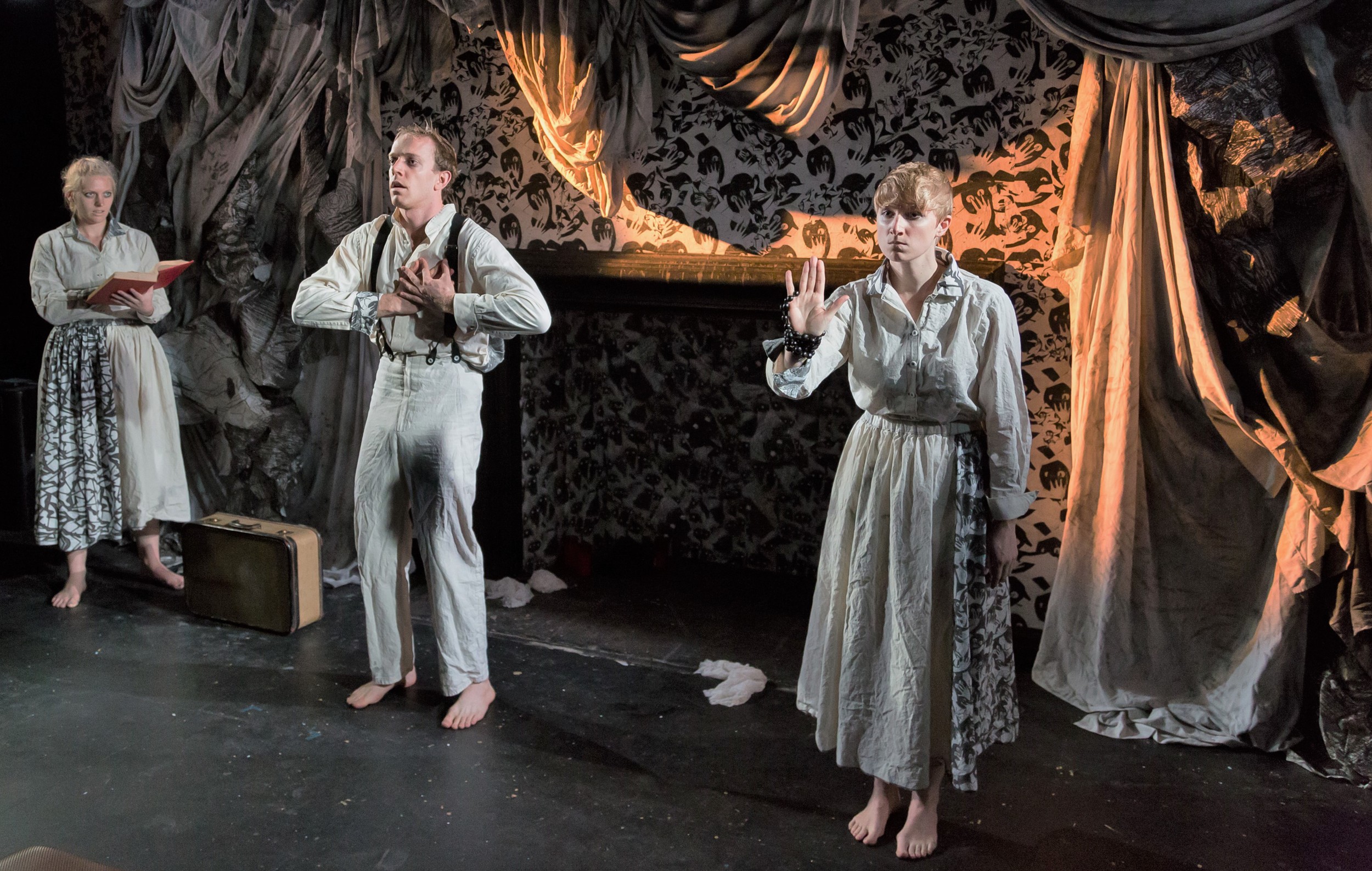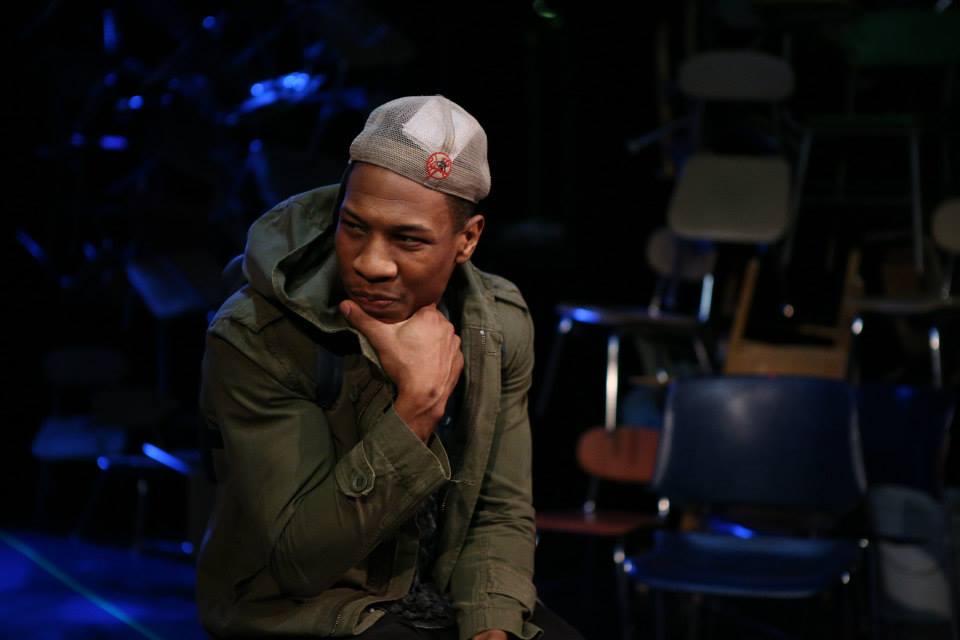Last weekend, the Yale Summer Cabaret ended its 2015 season with a production of Sarah Ruhl’s Orlando. Earlier this summer, in the season’s second slot, the Summer Cab offered a devised piece called love holds a lamp in this little room. At the time, the NHR site was going through an update and no review appeared. Here, for the record, is the review that didn’t get posted. The play’s director, Leora Morris, has begun her term as one of the co-artistic directors, with David Bruin and Julian Elijah Martinez, of the coming season’s Yale Cabaret. More about that later.—DB
Though it might wear inspiration from Branden Jacob-Jenkin’s entertaining and challenging play An Octoroon a bit too much on its sleeve, love holds a lamp in this little room, at Yale Summer Cabaret, directed by Leora Morris and conceived by the ensemble, is a richly associative work that makes much of its well-wrought visual sense and the inventive interplay of its cast.
The five actors—Melanie Field, Leland Fowler, Christopher Ross-Ewart, Elizabeth Stahlmann, Shaunette Renée Wilson—were set the task of devising vignettes to express or represent or comment on or allude to the varied self-conceptions, works, roles and autobiographical gestures—including a suicide note—of Adah Isaacs Menken, a curious celebrity of nineteenth-century American theater who was notorious for a role in which, playing a man, she allegedly rode nude upon a horse. She actually wore a body stocking, but that’s the kind of distortion and legend-managing that love holds a lamp comments on and, it may be, sustains.
Menken, who professed Judaism at some points and was most likely raised Catholic, also claimed kin with Creoles and, at times, voiced Confederate sympathies. We may assume that, as a person, she had her reasons, but the play isn’t out to explain her or to give her definitive tags. All five cast members “play” Menken, rendering her as a collective fantasy—ours, hers, and theirs.
Leland Fowler, Melanie Field, Shaunette Renee Wilson, Christopher Ross-Ewart, Elizabeth Stahlmann
The show opens with a group striptease, full of knowing smirks and suggestive play, with voice-overs that quote from Menken’s obituaries and notices. Revealing the unisex corsets and leotards worn by all, the playfulness of the opening extends to almost all aspects of the show. Especially served up for hilarity are operatic enactments of the kind of lurid dramas Menken starred in—particularly fun is Stahlmann as Menken as Lucretia Borgia.
But whereas An Octoroon used Boucicault’s play, The Octoroon, as the reference point for its re-imagining of racist motifs and sensationalist theater, love holds a lamp lacks a key structuring reference point. In an aggressively cut-and-paste manner, Morris and company let Menken surface through the words of her writings, of what is written about her, of roles she played. Just when we think we’re going to get a direct account we might get something else—an interlude of expressive coupling, a frenetic bit of vaudeville or clowning, a graveside monologue by a cowboy acquaintance (Ross-Ewart) speaking to a silent figure with a pantomime horse head.
Such descriptions make the play sound more bewildering than it is. Onstage, the routines are effective as a kind of fluidly gestural theater. Everything we see is happening in a pre-digested past that refuses to remain fixed, and the drama is in watching the cast tease out the various strands of Menken’s life. This they do with incredibly deft timing.
Much of the play’s success has to do with how it looks, presenting a pastiche of inventive costumes (Fabian Aguilar) on an oldtime playing space (Christopher Thompson) where the flicker of time itself seems present, thanks to a lighting palette from Joey Moro and projections from Rasean Davonte Johnson that effectively recreate the garish glare and expressionist shadows of gaslight footlights, as well as the shadowy dimness common to the era before electric lights. Here we’re treated to changeable acting styles, grandiloquent nineteenth-century phrasing, contemporary musical interludes, and even a clip from George Cukor’s Heller in Pink Tights with a staging of the horse ride of Mazeppa, featuring Sophia Loren in a blonde wig and a youngish Anthony Quinn scoring heavily in reaction shots.
Along the way, we get glimpses of “the Menken” as the kind of provocation she must have been to her contemporaries. Fowler walking about in white leggings and high-heeled boots, hanging up wardrobe, has a kind of grand resignation; Wilson, in man’s cutaway and top hat, gets shit-faced looking like a boorish carpetbagger, then later accompanies a sing-along on tambourine; Stahlmann, in a wedding dress, chews flowers and belts from a bottle concealed beneath her skirts, then sheds the array for a man’s coat-and-tails, vamping for Mr. Menken (Ross-Ewart), complete with prayer shawl, while the Menken’s views on marriage are heard in voice-over; “Answer Me,” a meditative poem by Menken, gets a lyrical rendering as a song sung by Ross-Ewart and Fowler; again and again the horsehead looms onto the stage, a recurrent reminder of the role Menken couldn’t live down.
The mix of motifs throughout the play—and the hovering question of race relations for a woman of mixed race who could pass as white—receives its most direct presentation in Melanie Field’s blackface enactment of Menken’s ambivalence about her racial identity. Field’s vignette includes partial nudity—part of the tease of Menken’s onstage persona—followed by dressing up in the trappings of stage stereotypes. Her self-aware miming manages to signal the extent to which, paradoxically, role-playing is necessitated by the very notion of stable identity. To Field also falls the delivery of a final speech written by Menken. Sounding like a somewhat skeptical Prospero trying to sum up her vexed relation to the theatricality of spectacle that made her name, Field makes us consider the pathos of the celebrity who becomes an appendage to her own reputation.
We might say that, at last, the show is a meditation on celebrity—the person behind a well-known aura can change, but how that person’s particulars are made to “mean” something audiences can bank on remains constant in the odd process of identification. Many people found “something” they wanted access to in Adah Isaacs Menken, during her life, and love holds a lamp in this little room is at its best in questioning what that might have been, all the while deconstructing its own processes of enactment and identification.
Love holds a lamp in this little room is one of the best devised pieces I’ve seen at the Cabaret and a fine follow-up to Midsummer, the summer season’s pastiche of Shakespearean romance that preceded it.
love holds a lamp in this little room
Based on the life and writings of Adah Isaacs Menken
Created and performed by the Company
Conceived and directed by Leora Morris
Scenic Design: Christopher Thompson; Costume Design: Fabian Aguilar; Lighting Design: Joey Moro; Sound Design: Kate Marvin; Projection Design: Rasean Davonte Johnson; Dramaturg: Kate Marvin; Stage Manager: Emely Zepeda
Ensemble: Melanie Field, Leland Fowler, Christopher Ross-Ewart, Elizabeth Stahlmann, Shaunette Renée Wilson
Yale Summer Cabaret
July 9-July 18, 2015









